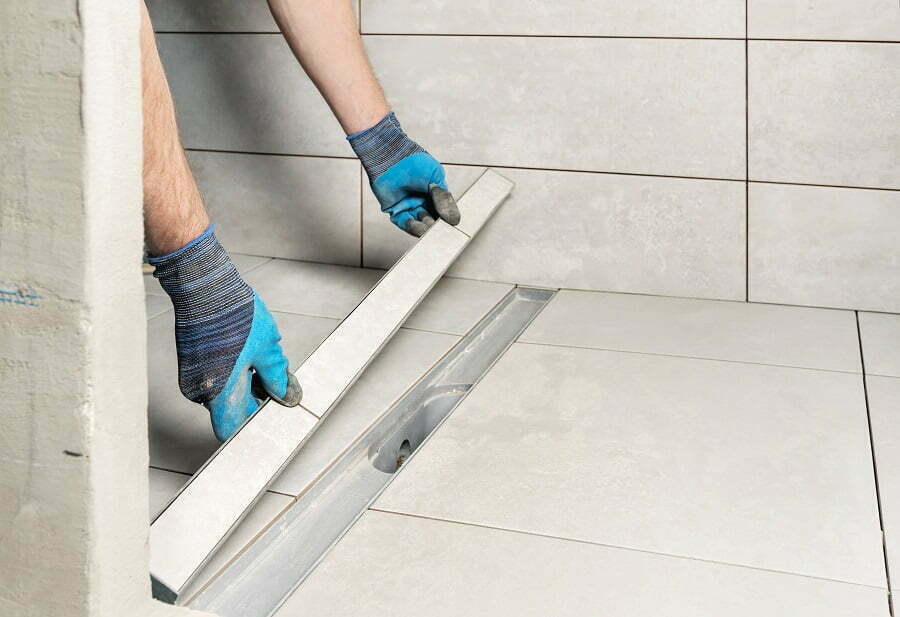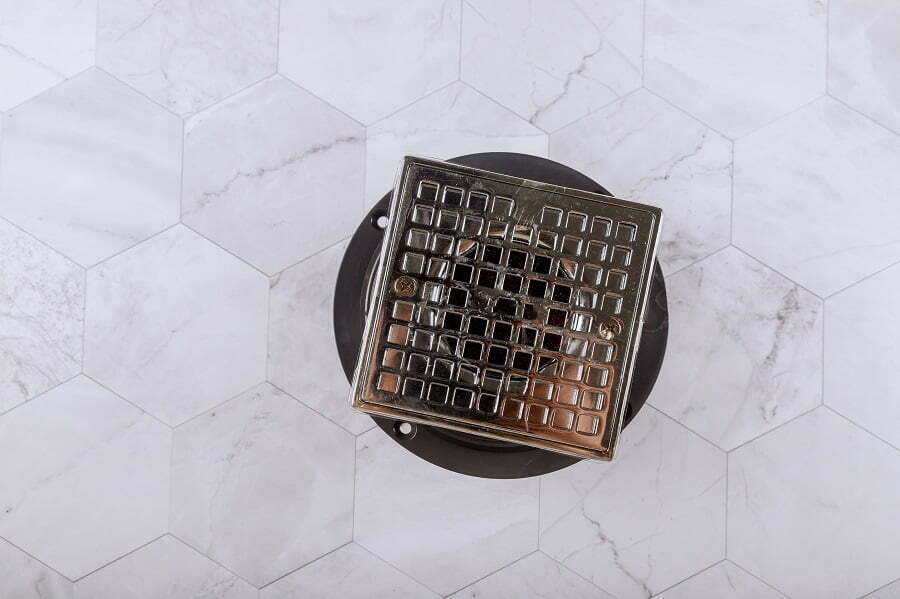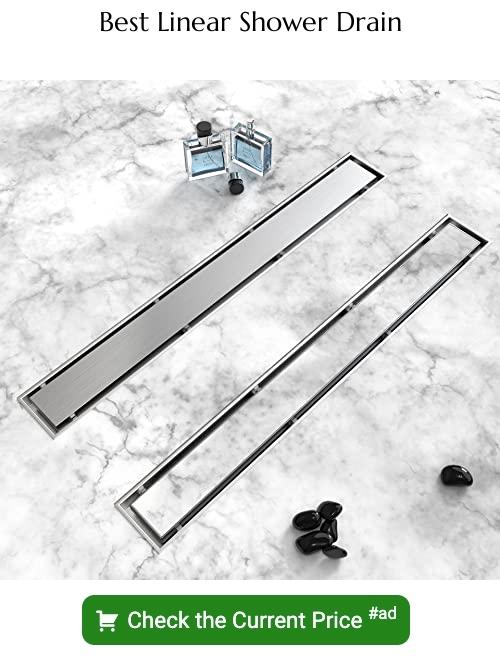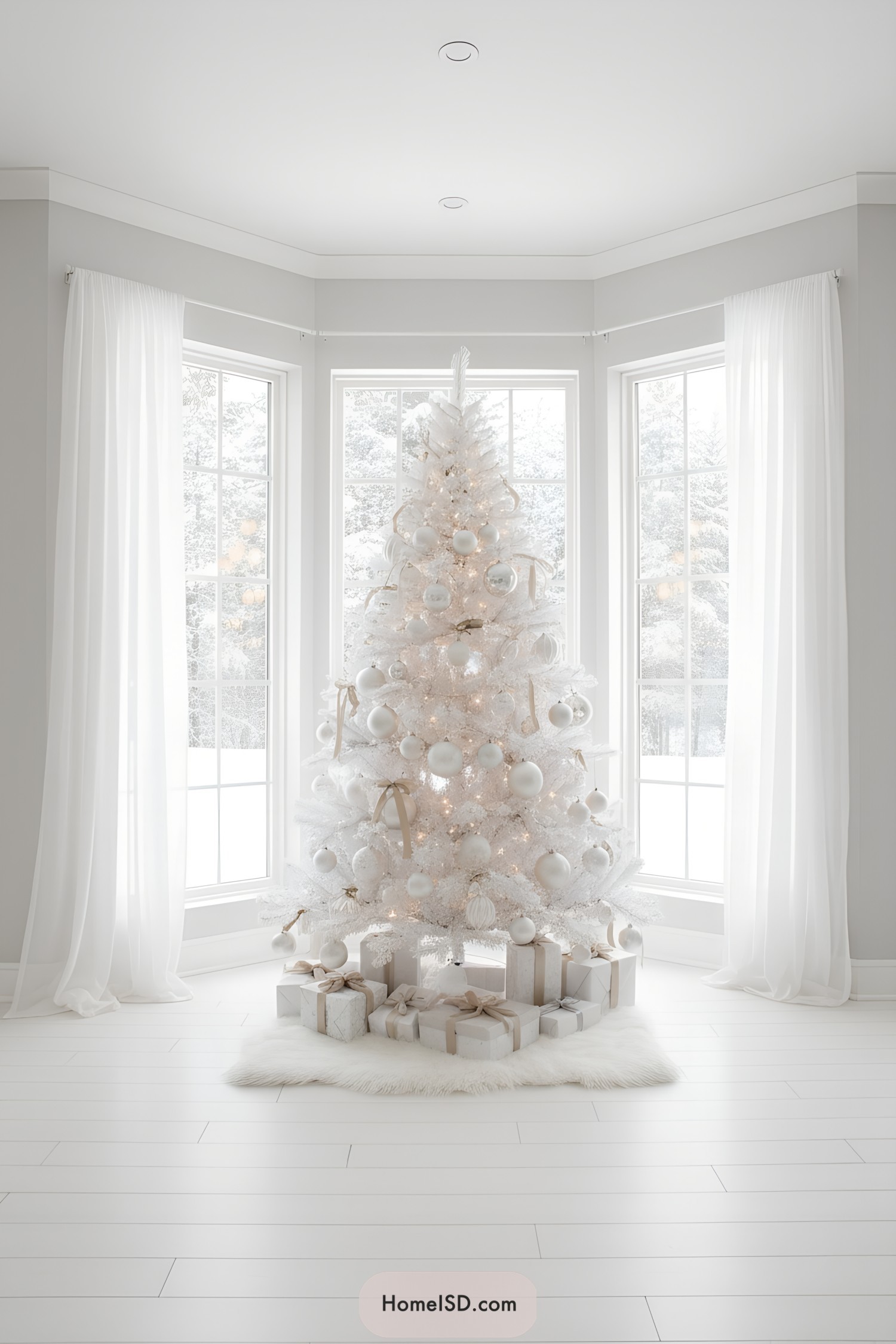Last updated on
Can’t decide if a linear shower drain is right for you? Let’s compare the two popular types of drains and find out if linear drains are better. Read on!
In a nutshell, linear shower drains are better if:
- You’re after a trendy bathroom design.
- You want to invest into design that can wow people.
- You want to use large tiles on your shower floor.
- You have a curbless shower.
Otherwise, you might as well save money because there are points where point drains excel. The latter are inexpensive, effective, and work on most shower floors.
But let’s not take it at face value. Let’s explore and compare the two drains to make a well-informed decision.
What is a Linear Shower Drain?

Linear or trench drains don’t collect water at your feet like traditional point drains. Instead, they drain the water in a channel through the shower floor and onto a hidden outlet to decrease standing pools of water. A linear drain is flat with small channels that collect fewer standing pools of water because it doesn’t often fill up with much more than an inch or two of fluids drained by gravity quickly.
It is best to have a floor that slopes towards the drain because water will flow with gravity. A generous grate helps keep debris out of the drains, making cleaning easier and improving safety.
Important Nuances of a Linear Drain
The most important feature of a linear drain is the unpredictability of its performance. For example, linear drains can be bumpy or have certain portions angled downward in an inappropriate way that makes them more difficult to clean.
We would say it is puzzling about a linear drain if it has any rough or sharp materials on it; this will be also harder to clean, and those areas may even become painful for someone’s feet after stepping on them many times.
Lastly, another problem with these drains is how they easily get clogged due to hair getting tangled around or crushed under the edges of the drain hole.
Why Choose a Linear Shower Drain?
A linear drain can be covered with decorative channel covers or tiled to match, while a traditional drain will draw attention. A linear drain’s sleek and stylish design makes for a visually appealing shower that blends into the other visual elements of the area.
The linear design of a drain can help make your shower seem more spacious. They allow for integrated tile work, so you don’t feel that there are two separate areas in the same space.
The linear drain is flat and smooth, moving water away quickly. This type of drain is easy to use for those with disabilities.
Rigid channels are usually more durable. When cemented properly, rigid channels can support weight and won’t have sharp edges that cause a hazardous trip.
You might use a linear drain in bathrooms, garages, or even outside if there is a fountain. The main use of the linear drain is to collect water. This prevents potential damage on areas where water can last for long periods due to constant exposure. Linear drains are popular because they offer wall-to-wall coverage, eliminating the puddles and other stagnant pools that could cause problems.
Maintenance with a linear drain is easy. They are simple to lift off with a key tool, and you can put debris shields over them. The water flows through, debris accumulates in the channel, but it is easily wiped down if there are signs of build-up.
Linear Drain vs. Point Drain

Linear drains are much more expensive than point drains. A point drain costs a lot less, which is why they are so popular.
It is best to use a linear if you want a large-format tile and minimal grout. Tile and grout are treated differently depending on the kind of either. If you want to use tiles that cover the entire floor, then use a center drain. This design can be an inverted pyramid with corner-to-drain cut/grout lines, but diagonal cuts can look awkward when combined with any other grout lines.
Another pro of using a linear drain is increased flow speed through the stage—due to an increase in height—and decreased sloping radius by more than ten times. The cons are construction costs due to additional floor slope design consideration and decreased efficiency because of eliminating surface water.
Some people think that linear drains are less safe than point drains, while others say they can handle more water and wastewater. But no matter what the preference is, it always comes down to personal opinion. A linear drain is often not curbless as it does not meet with a physical barrier such as a curb or other raised material at its borders, meaning it has the potential to cause other hazards in careless situations where people may accidentally walk into the water.
Another advantage to using linear drains is installing large-format tiles, which create an uninterrupted grout line and uses all of the surface areas on the tile. These drains are advantageous for larger spaces and spaces where a point drain would require corners or edges.
Point drains are often cheaper.
Linear drains are designed to drain the water from one side of a shower or tub. The biggest advantage is that it can be located in any place without hindering bathroom use. The disadvantage is that it takes more room, and there may not be enough, depending on your layout and design choices.
Linear drains often don’t have weep holes either, due to the way they are designed to be installed with a waterproof membrane.
Drain Sizing
According to the National Kitchen and Bath Association, a person installing drainage needs to know how much water will be pouring out of the shower. To figure it out, consider how much water will pour from the showerhead plus some extra for runoff that is accumulating on top of the tile.
Many linear drain lines come in preset sizes and lengths. For example, the standard minimum channel is 24 inches, and you can adjust these to the needs of any space by cutting down the lengths or connecting them with bridge pieces. These drains are available with either a standard outlet drain installation or their side outlet installation, where the corresponding option will lead to rerouting processes.
Installation Options
A linear drain feature runs the shower’s length. The more often a linear drain flows, the less often it needs its liner changed, so they are installed primarily to prevent recurring maintenance costs. There are many reasons someone would install one of these features, including high water volume or low slope floor.
When installing a drain, it should be positioned flush against the shower wall. For modern waterproofing techniques, you can install a fixed-flange channel in which there is no need for any tiling behind the drain. This is an optimal solution as it prevents water splash from going to the wall of a tile or shower and gives you added padding if you are going with normal tiles.
It is also possible to position the linear drain near the threshold or door of the shower to keep water from spilling out of the shower area and ensure that all liquid flows into the drain. Showers with glass doors or raised curbs must use a wider channel cover since there is an extra area without liquid to capture. A linear drain should be placed either at your threshold, on your door, or in any place where water can seep through.
Some designs might require a curb or some wall around the area to be flooded. However, when the floor area is level and flat between the intended shower area and the rest of the bathroom, barrier-free installation could work instead. The barrier-free installation allows for tile patterns connected throughout the entire bath space rather than being altered in certain areas where wet meets dry. Flooded floors would still need a slope towards the drain.
A point drain has a square-shaped trough that the water is supposed to drop from. This type of drain should be centered in the shower space and will have to slope down towards it in all directions. The type of drainage system you purchase will depend on the flooring material your bathroom has, how large the area is, whether or not there are obstacles like wainscoting surrounding the area, etc.
Linear Drain Cover Types
The finished grate covers are designed to catch larger debris and prevent it from making it to the drain while still allowing for easy water flow into the channel. Some cover types limit the flow rate of water to the drain because of their design, so be sure you choose one that will best suit likely water flow demands on your shower.
To ensure easy maintenance, you can lift drains out with a specialized tool called a key, and this will allow access to clear away debris. A removable debris basket covering the drain outlet makes clean-up easier and ensures a longer life for your plumbing system (i.e., if you do routine cleanings every month).
Tile insert channel covers have become popular where you can lay tiles and patterns on that surface. The water drains into the channels beneath and will not come back out of the drain. These are less useful for shower areas because they restrict flow rates.
The grated-channel cover can have a traditional pattern/arrangement, such as a plain metal grid or something more sophisticated, such as engraved panels with intricate designs. This is installed evenly with the surrounding tile to make sure that walking on it is comfortable.
Linear Drain Floor Slope
Linear drain floor slope is mostly used as a drainage solution. The test has been performed that shows linear drains do have the risk of being riddled with clogging and have the self-cleaning function, which minimizes that risk.
No different from center pitch drains, linear drains require a gentle 0.25-inch slope per foot. However, the difference is how much the slope creates an angle for them. For example, if you measure back from the shower wall about four feet, the ground level should be 1 inch lower than that point, creating a funnel effect to guide water.
In designing a floor for a shower enclosure, drain manufacturers usually recommend larger tiles than normally used in the design. One limitation with using large tiles is that the coloring and pattern options are much more limited. The main advantage to small tile designs (tiles of approx. 4” sq.) is their ability to save on grouting material, thereby moving more water through the drain while excavating less flooring by sealing off sections from grout protrusions. The slope of a traditional point drain features smaller tiles (cuts down use), which adds to its curvature (adds movement). Smaller-size tiles limit color options and patterns (limits creativity), meaning the design will be quite narrow in variability.
Linear drains are used to make the floor more evenly. They also help with waste disposal because the drain will effortlessly pull sludge away.
Point Drain
Point drains are inexpensive and easy to install, making them the most popular solution for homes. For installation, these drains are the cheapest and easiest.
Tile guys are used to installing point drains. We recommend getting shower floor tile that is under 4 inches so people can better fit on the pan and the drain.
Point drains are one of the best options for showers because they have little to no maintenance. It also makes cleaning easier. This drain in a shower is more sturdy and cleaner than another available type.
A point drain can be mounted in any shower. It is the most versatile choice if commonly used.
Point drains are not as pretty to see. They might not be the best option if you want a stunning-looking or beautiful drain.
Point drains are often the most cost-effective option. They’re still functional. And you can get them in as many designs as you want. These drains are more functionally effective and also cheaper than a drain near the wall.
FAQ
Linear shower drains have decorative value, they are easy to maintain, they provide better water drainage flow, they allow you to use large tiles.
You should use a linear drain if you want to impress, or if you want to have a better water drainage flow, or if you have a curbless shower, and if you can afford the expense.
Typically a linear drain is placed along a side wall or back wall. But no one says you can’t place it in the center as well.
The linear drain cover is easily removed allowing you to easily clean it.
Recap





